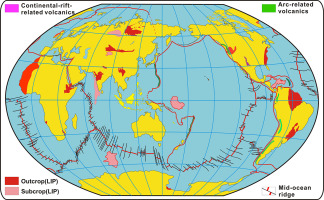当前位置:
X-MOL 学术
›
Gondwana Res.
›
论文详情
Our official English website, www.x-mol.net, welcomes your
feedback! (Note: you will need to create a separate account there.)
Basalt geochemistry as a diagnostic indicator of tectonic setting
Gondwana Research ( IF 7.2 ) Pub Date : 2019-01-01 , DOI: 10.1016/j.gr.2018.08.006 Linqi Xia , Xiangmin Li
Gondwana Research ( IF 7.2 ) Pub Date : 2019-01-01 , DOI: 10.1016/j.gr.2018.08.006 Linqi Xia , Xiangmin Li

|
Abstract Basalt geochemistry can be used as a diagnostic indicator for determining the tectonic setting of origin, because specific plate tectonic settings often impart distinctive geochemical characteristics. For example: (1) mid-ocean ridge basalts (MORB) and oceanic island basalts (OIB) have clearly distinguishable trace element and Sr-Nd isotope geochemical characteristics; (2) arc related basalts, including IOAB (intra-oceanic arc basalts), IAB (island arc basalts) and CAB (continental arc basalts), exhibit following distinguishing features: all are characterized by low Nb/La ratios ( 1, “hump-shaped” OIB-like trace element patterns and moderate positive ɛNd values that distinguish them from the arc related ones; whereas, the contaminated continental intraplate basalts are characterized by pronounced negative Nb, Ta and Ti anomalies, but their concentrations of incompatible trace elements are conspicuously higher than those of subduction-zone basalts that also distinguishes them from the arc related ones; (4) an important difference between back-arc basin basalts (BABB) and the MORB is that the former exhibit both MORB-like and arc-like geochemical characteristics; (5) most oceanic plateau basalts (OPB) show diagnostic geochemical characteristics of enriched MORB (E-MORB) to transitional MORB (T-MORB); only the Kerguelen Plateau is an exception; the early (pre 90 Ma) volcanism of the Kerguelen Plateau is associated with the Early Cretaceous break-up of Gondwana and displays features of continental flood basaltic volcanism; with time, the tectonic setting of the Kerguelen plume-derived volcanism changed from a rifted continental margin setting (133–118 Ma) through a young, widening ocean (118–40 Ma), finally to an oceanic intraplate setting (~40 Ma to the present). Tectonic discrimination diagrams should not be used in isolation, but can still be useful as part of holistic geochemical characterization. For example: (1) MORB and OIB are distinguishable from each other in the 3Tb-Th-2Ta diagram; (2) the arc related basalts, including IOAB, IAB and CAB, constantly plot in the arc-related basalts fields in the Th/Yb-Ta/Yb diagram; (3) the 3Tb-Th-2Ta diagram can be utilized to fully illustrate both MORB-like and arc-like characteristics of BABB; (4) some discriminant diagrams (such as Zr/Y-Zr, Th/Yb-Ta/Yb, 3Tb-Th-2Ta and Hf/3-Th-Nb/16 diagrams) can be used to distinguish continental intra plate basalts from arc related ones; (5) although there are not any discrimination diagrams published that delineate an OPB field, some trace element diagrams can still reveal diagnostic characteristics of the OPB.
中文翻译:

玄武岩地球化学作为构造环境的诊断指标
摘要 玄武岩地球化学可作为确定起源构造环境的诊断指标,因为特定的板块构造环境往往赋予独特的地球化学特征。例如:(1)洋中脊玄武岩(MORB)和大洋岛玄武岩(OIB)具有明显可区分的微量元素和Sr-Nd同位素地球化学特征;(2) 弧相关玄武岩,包括 IOAB(洋内弧玄武岩)、IAB(岛弧玄武岩)和 CAB(大陆弧玄武岩),表现出以下显着特征:均以低 Nb/La 比率为特征(1,“驼峰”形”OIB 样微量元素模式和适度的正 ɛNd 值,将它们与弧相关的区分开来;而被污染的大陆板内玄武岩的特征是显着的负 Nb、Ta 和 Ti 异常,但它们的不相容微量元素的浓度明显高于俯冲带玄武岩,这也将它们与弧相关玄武岩区分开来;(4)弧后盆地玄武岩(BABB)与MORB的一个重要区别是前者同时具有MORB状和弧状地球化学特征;(5) 大部分大洋高原玄武岩(OPB)显示出富集MORB(E-MORB)到过渡MORB(T-MORB)的诊断地球化学特征;只有凯尔盖朗高原是个例外;凯尔盖朗高原的早期(90 Ma 之前)火山活动与冈瓦纳大陆早白垩世的破裂有关,并显示出大陆洪水玄武岩火山活动的特征;随着时间的推移,凯尔盖朗羽状火山活动的构造环境从裂谷大陆边缘环境(133-118 Ma)转变为年轻的、海洋扩大(118-40 Ma),最终形成大洋板块内环境(~40 Ma至今)。构造区分图不应单独使用,但仍可作为整体地球化学特征的一部分使用。例如:(1)MORB和OIB在3Tb-Th-2Ta图中是可以区分的;(2) 弧相关玄武岩,包括IOAB、IAB和CAB,在Th/Yb-Ta/Yb图的弧相关玄武岩场中不断绘制;(3) 3Tb-Th-2Ta图可以充分说明BABB的类MORB和类弧特性;(4) 一些判别图(如Zr/Y-Zr、Th/Yb-Ta/Yb、3Tb-Th-2Ta和Hf/3-Th-Nb/16图)可用于区分大陆板块内玄武岩和弧相关的;(5) 尽管没有发布任何描述 OPB 字段的区分图,
更新日期:2019-01-01
中文翻译:

玄武岩地球化学作为构造环境的诊断指标
摘要 玄武岩地球化学可作为确定起源构造环境的诊断指标,因为特定的板块构造环境往往赋予独特的地球化学特征。例如:(1)洋中脊玄武岩(MORB)和大洋岛玄武岩(OIB)具有明显可区分的微量元素和Sr-Nd同位素地球化学特征;(2) 弧相关玄武岩,包括 IOAB(洋内弧玄武岩)、IAB(岛弧玄武岩)和 CAB(大陆弧玄武岩),表现出以下显着特征:均以低 Nb/La 比率为特征(1,“驼峰”形”OIB 样微量元素模式和适度的正 ɛNd 值,将它们与弧相关的区分开来;而被污染的大陆板内玄武岩的特征是显着的负 Nb、Ta 和 Ti 异常,但它们的不相容微量元素的浓度明显高于俯冲带玄武岩,这也将它们与弧相关玄武岩区分开来;(4)弧后盆地玄武岩(BABB)与MORB的一个重要区别是前者同时具有MORB状和弧状地球化学特征;(5) 大部分大洋高原玄武岩(OPB)显示出富集MORB(E-MORB)到过渡MORB(T-MORB)的诊断地球化学特征;只有凯尔盖朗高原是个例外;凯尔盖朗高原的早期(90 Ma 之前)火山活动与冈瓦纳大陆早白垩世的破裂有关,并显示出大陆洪水玄武岩火山活动的特征;随着时间的推移,凯尔盖朗羽状火山活动的构造环境从裂谷大陆边缘环境(133-118 Ma)转变为年轻的、海洋扩大(118-40 Ma),最终形成大洋板块内环境(~40 Ma至今)。构造区分图不应单独使用,但仍可作为整体地球化学特征的一部分使用。例如:(1)MORB和OIB在3Tb-Th-2Ta图中是可以区分的;(2) 弧相关玄武岩,包括IOAB、IAB和CAB,在Th/Yb-Ta/Yb图的弧相关玄武岩场中不断绘制;(3) 3Tb-Th-2Ta图可以充分说明BABB的类MORB和类弧特性;(4) 一些判别图(如Zr/Y-Zr、Th/Yb-Ta/Yb、3Tb-Th-2Ta和Hf/3-Th-Nb/16图)可用于区分大陆板块内玄武岩和弧相关的;(5) 尽管没有发布任何描述 OPB 字段的区分图,











































 京公网安备 11010802027423号
京公网安备 11010802027423号